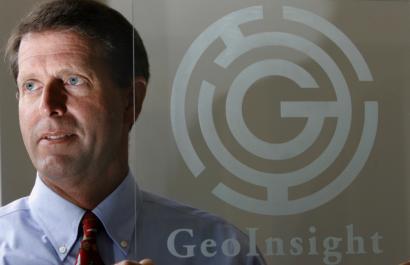.Green era opens doors for firm
GeoInsight takes proactive stance

John A. Gilbert, CEO of GeoInsight, an environmental and engineering consulting firm, in his Manchester, N.H., office. (JOANNE RATHE/GLOBE STAFF)
In his 14 years as founder and chief executive of GeoInsight Inc., an environmental and engineering consulting firm, John A. Gilbert has seen a big change in the way business is conducted.
"For years, [federal and state] regulatory revisions had driven this industry," Gilbert, 50, recalled last week during an interview in the firm's Manchester, N.H., corporate offices. "But now, companies and organizations are focusing more on environmental management, looking at ways of heading off problems and reducing costs."
Although this is clearly a green era, there are still many companies that don't want to discuss publicly how they are addressing environmental problems, Gilbert acknowledged. But things are moving in the right "environmentally friendly direction," he said.
His small firm's goal, which he said it is achieving, is to work with clients as partners on environmental quality concerns.
And as the firm has become better known for its work in New England, annual revenues are on the rise, hitting the $10 million mark last year, Gilbert said, adding that revenues are now increasing between 15 and 20 percent a year.
But it hasn't always been easy street.
"At one time, we found that we weren't being taken seriously because we were perceived to be too small," Gilbert said. "But that's changed."
Similarly sized environmental consulting firms are the competition today rather than giants like Cambridge-based CDM, which, he said, have largely become federal government contractors.
GeoInsight has 35 employees in Manchester, 14 employees in Westford, Mass., and 13 employees in Cheshire, Conn.
One of the environmental consulting industry's biggest challenges in recent years has been finding quality people with experience, Gilbert said. In some cases, he added, "we find strong entry-level people and bring them along as fast as we can."
Approximately 50 percent of GeoInsight's projects are in Massachusetts, according to Gilbert and Michael C. Penney, 45, a senior associate-senior engineer and manager of the Manchester operation. The rest are in Connecticut (25 percent), New Hampshire (20), and Rhode Island, Vermont, Maine, and New York.
Each year, the firm handles between 300 and 400 projects, Gilbert said. Since its founding in 1993 in Londonderry, N.H., GeoInsight has worked on more than 3,000 projects, he said. Most of the clients have been in the private sector, but there also have been some public sector customers such as municipalities.
"For a small firm, we now cover a lot of ground and are perhaps best known for our assessments of contaminated sites," in terms of air and water quality and other issues, said Gilbert, who grew up in Concord, Mass., and now lives in Concord, N.H.
A number of those sites have been Superfund properties, or those cited by the US Environmental Protection Agency as being the most severely polluted.
Gilbert said GeoInsight's first project involved the Savage Well Superfund site in Milford, N.H. Among the firm's clients currently for Superfund site work are the town of Wilmington, Mass., for the Olin Chemical property, and the Citizens Research and Environmental Watch group, or CREW, of Concord, Mass., for the
"We are very satisfied with the technical advice we've been getting from GeoInsight for the last five years," said James West, technical assistance coordinator for CREW, which receives federal grants for its Starmet-site monitoring work. "Unlike some other firms, they are very experienced in Superfund site work, particularly in the area of hydrology," West said.
One of the most complicated projects handled by GeoInsight, Gilbert pointed out, dealt with drilling a water main under the Thames River in Connecticut to increase the water supply for the Mohegan Sun Casino, the town of Montville, where the casino is, and surrounding communities. The project was completed early last year, he said.
While overseeing complicated as well as more straightforward projects, Gilbert said he is also committed to what he calls GeoInsight's "inner ownership.
"I started the firm because I wanted to run my own business after being a field engineer. But I also wanted to create an organization that would be very different in this field, a stewardship model that would emphasize collegiality."
GeoInsight now has an employee stock ownership plan worth about $300,000, and Gilbert said he will sell his total interest in the firm to employees, perhaps by year's end.
"My ownership stake will then go down to zero, but I'll remain chief executive," he said. "There are exciting times ahead for this still-evolving industry.
Large companies seek to stem costs associated with data center energy use, which is predicted to soar to $7.4 billion in 2011, from $4.5 billion in 2006More than half of large companies are moving beyond talking and into actual planning stages for making their data centers "greener," according to a study that will be released next month by data center operator Digital Realty Trust.

No comments:
Post a Comment